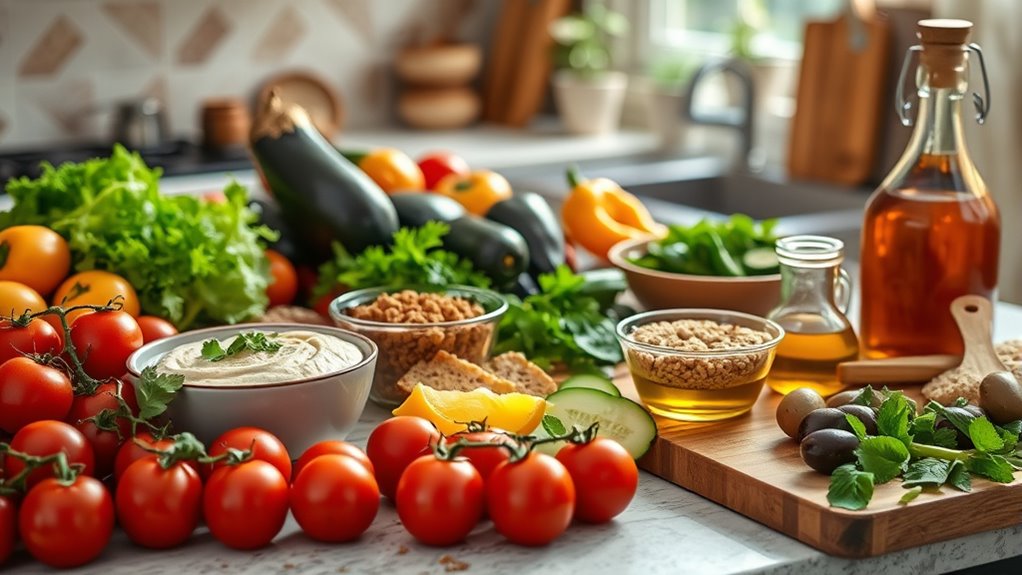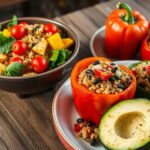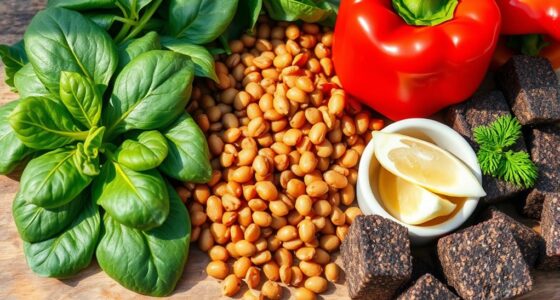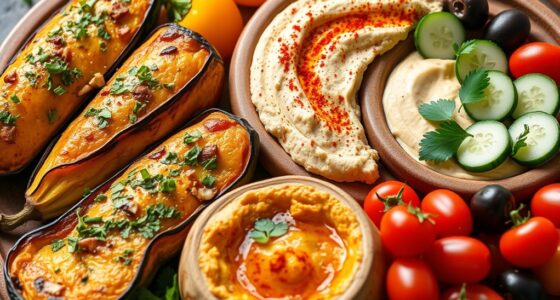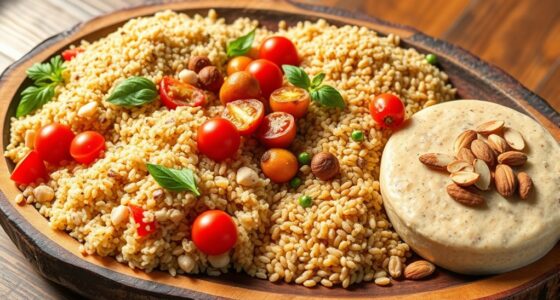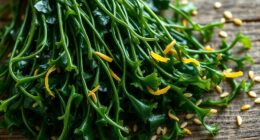To shift from meat to a Mediterranean‑style vegetarian diet, start by gradually reducing red meats, replacing them with legumes, grains, nuts, and fresh vegetables. Focus on incorporating traditional herbs, olive oil, and seasonal ingredients into your meals for delicious flavors. Plan ahead with batch prep and explore easy, authentic recipes that emphasize plant-based proteins. As you progress, you’ll develop sustainable habits that align with cultural roots and focus on health, enjoyment, and long-term wellness—discover how to make it seamless and satisfying.
Key Takeaways
- Gradually reduce meat intake, replacing red meats with plant proteins like legumes and nuts over several weeks.
- Incorporate traditional Mediterranean vegetarian dishes emphasizing seasonal produce, olive oil, and whole grains.
- Plan weekly meals with balanced, colorful ingredients to develop sustainable, enjoyable eating routines.
- Use mindful eating and tracking tools to monitor progress and maintain motivation during the transition.
- Stock pantry staples such as grains, legumes, herbs, and healthy fats to facilitate quick, flavorful Mediterranean vegetarian meals.
Understanding the Core Principles of the Mediterranean Diet
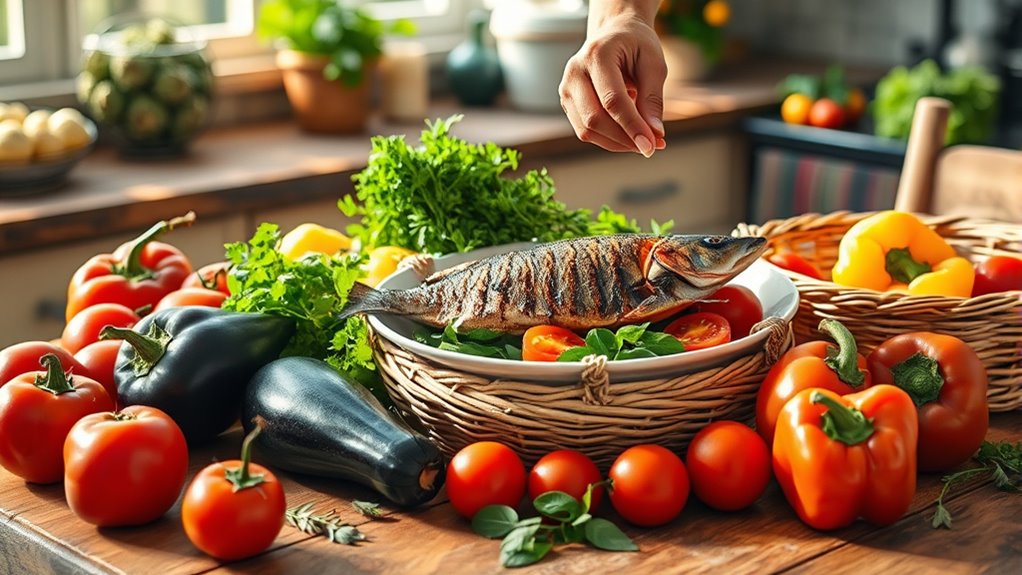
The Mediterranean diet is centered on simple, wholesome foods that promote health and well-being. Its roots trace back through Mediterranean diet history, shaped by centuries of cultural influences from countries bordering the Mediterranean Sea. These traditions emphasize fresh fruits, vegetables, whole grains, legumes, nuts, and olive oil, with moderate consumption of fish and dairy. The diet’s core principles focus on balanced eating, enjoying meals with family and friends, and valuing fresh, seasonal ingredients. Cultural influences have helped develop a flexible, sustainable approach to eating, rather than rigid rules. By understanding these principles, you’ll appreciate the diet’s emphasis on natural foods and social connections, which are crucial for long-term health and enjoyment. This foundation sets the stage for a fulfilling vegetarian transition.
Gradually Reducing Meat Consumption
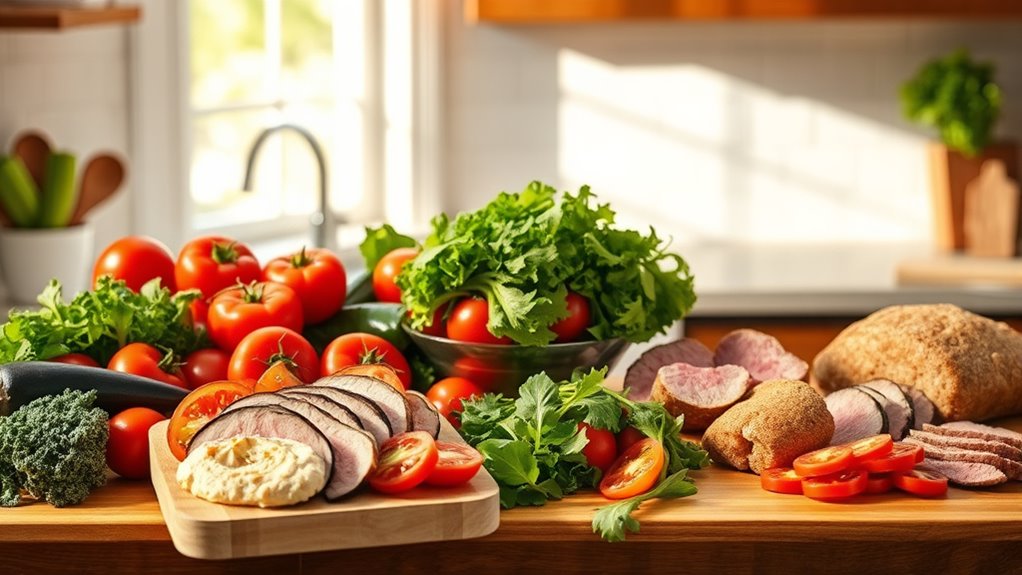
To successfully shift to a vegetarian diet, it’s best to start by gradually reducing your meat intake rather than cutting it out all at once. This approach helps your body and habits adjust comfortably, making the change sustainable. Focus on incorporating meat alternatives like beans, lentils, and plant-based proteins. Consider ethical considerations, such as reducing animal suffering, which can motivate your changeover. To help visualize your progress, here’s a simple plan:
| Week | Meat Reduction Goal |
|---|---|
| 1 | Cut back on red meats, replace with plant proteins |
| 2 | Limit poultry, introduce more vegetarian meals |
| 3 | Reduce fish consumption, explore meat alternatives |
| 4 | Make vegetarian dishes the main part of meals |
| 5+ | Minimize or eliminate added meats in recipes |
Gradually, these small steps will make your switch smoother and more lasting. Incorporating sound healing science techniques, such as mindful eating with calming music, can also support your transition by enhancing relaxation and emotional well-being. Additionally, maintaining a growth mindset can help you adapt to dietary changes more positively, reinforcing long-term success.
Incorporating Plant-Based Proteins Into Your Meals
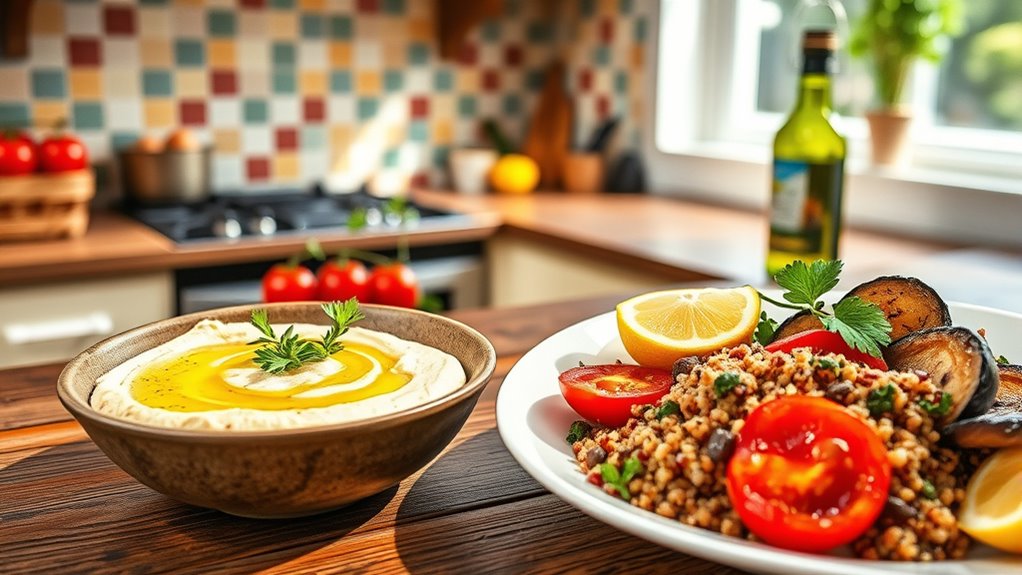
Adding protein-rich legumes like chickpeas and lentils is an easy way to boost your meals. Nuts and seeds also provide healthy fats and extra protein to keep you full. Incorporating these into your dishes makes your shift to a Mediterranean vegetarian diet simple and satisfying.
Protein-Rich Legumes
Incorporating protein-rich legumes into your meals is an excellent way to boost your plant-based protein intake and support a balanced Mediterranean vegetarian diet. Legume varieties like chickpeas, lentils, black beans, and kidney beans offer diverse flavors and textures. To maximize their nutritional value, focus on protein pairing—combining legumes with grains, nuts, or seeds enhances amino acid profiles. Use the table below to explore popular legume options and ideal pairings:
| Legume Variety | Protein Pairing |
|---|---|
| Chickpeas | Whole grains (quinoa, bulgur) |
| Lentils | Brown rice, barley |
| Black beans | Corn, whole wheat tortillas |
| Kidney beans | Millet, farro |
| Peas | Bulgur, pine nuts |
Experiment with these combinations to create satisfying, nutrient-dense meals that keep your diet Mediterranean and vegetarian.
Nut and Seed Boosts
Nut and seed boosts are an easy and delicious way to increase your plant-based protein intake within a Mediterranean vegetarian diet. Incorporating these nutrient-dense options into your meals or snacks offers a simple way to fuel your body with healthy fats, fiber, and protein. You can sprinkle chopped nuts or seeds onto salads, yogurt, or oatmeal, or enjoy them as quick plant-based snacks. Almonds, walnuts, sunflower seeds, and chia seeds are all excellent choices that add flavor and texture while boosting your nutritional profile. These nut and seed boosts are versatile, portable, and satisfying, making them perfect for busy days. By including them regularly, you support your progression to a more plant-focused diet without sacrificing taste or convenience. Additionally, exploring popular nut and seed varieties can help you diversify your nutrient sources and keep your meals interesting, as they are rich in essential nutrients that support overall health. Incorporating a variety of plant-based protein sources can further enhance your diet and provide a broader spectrum of health benefits. Furthermore, understanding the nutritional benefits of seeds and nuts can empower you to make informed choices that align with your health goals.
Exploring Delicious Mediterranean Vegetarian Recipes
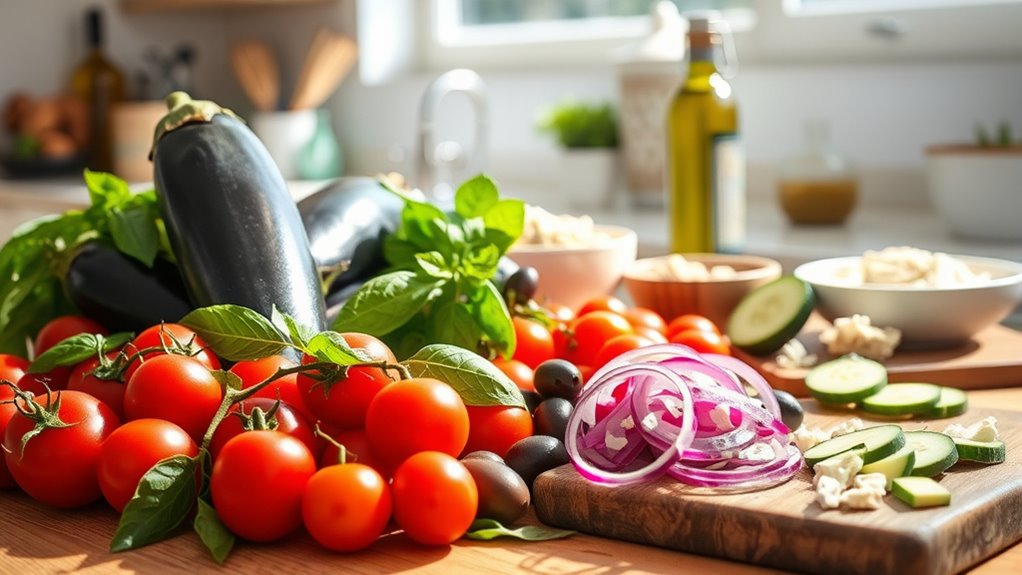
Discovering flavorful Mediterranean vegetarian recipes opens up a world of fresh ingredients and vibrant flavors that can transform your meals. You’ll find creative ways to use meat substitutes like grilled eggplant, chickpeas, and tofu, giving your dishes satisfying protein without meat. Mediterranean recipes emphasize wholesome vegetables, herbs, and olive oil, creating hearty salads, stews, and grain bowls. Incorporating essential oils into your cooking or wellness routine can also enhance your dining experience, offering additional health benefits. Don’t forget to indulge in Mediterranean desserts like baklava or fresh fruit with honey, which add sweetness and authenticity to your menu. These recipes are simple to prepare and packed with flavor, making meatless meals exciting and satisfying. Exploring this cuisine allows you to enjoy a diverse range of tastes while embracing a healthier, plant-based lifestyle. Vetted conversion kits are also available to upgrade your bike for easier city riding and longer distances.
Stocking Your Kitchen With Essential Ingredients
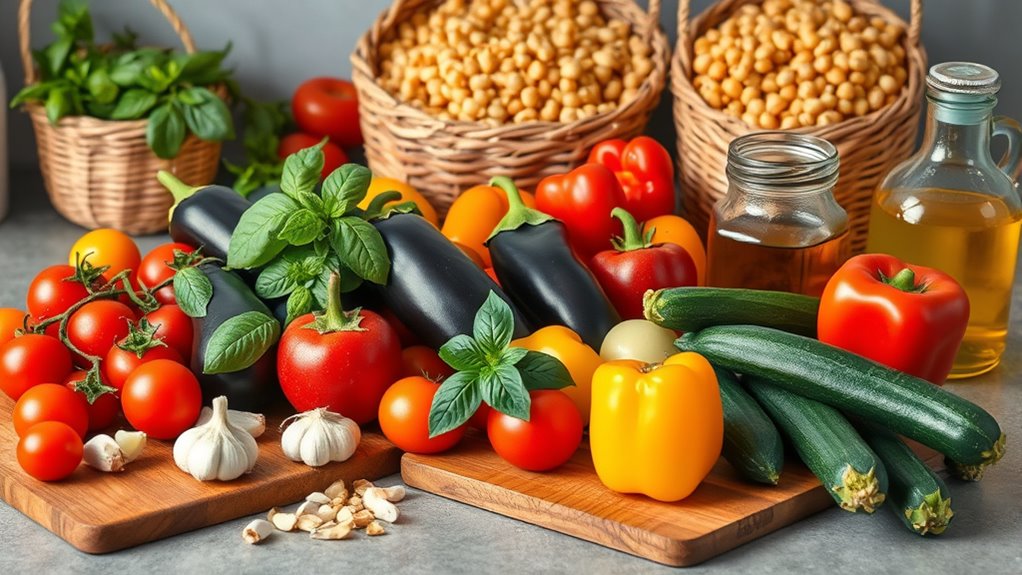
To start your Mediterranean vegetarian journey, make sure your pantry is stocked with key grains like couscous, rice, and lentils. Keep fresh produce such as tomatoes, cucumbers, and bell peppers on hand, along with flavorful herbs and spices like thyme, oregano, and garlic. These essentials will help you create vibrant, authentic dishes with ease. Incorporate nutrient-rich ingredients to customize your kitchen tools for better performance and efficiency. Using grocery savings strategies can help you purchase quality ingredients at a lower cost. Don’t forget to organize your supplies with practical storage solutions to keep your ingredients fresh and accessible.
Pantry Staples and Grains
Having a well-stocked pantry is essential for preparing delicious Mediterranean vegetarian meals. Keep a variety of grains like quinoa, bulgur, farro, and brown rice, which form the base of many dishes. Stock canned or dried beans such as chickpeas, lentils, and cannellini beans for protein and texture. Include meat alternatives like tofu, tempeh, or plant-based patties, which offer versatile options for hearty dishes. Dairy substitutes like almond milk, coconut yogurt, and vegan cheese help replicate traditional flavors without animal products. Spices like cumin, paprika, and oregano add authentic Mediterranean flavor. Don’t forget pantry staples like olive oil, vinegar, canned tomatoes, and capers. Incorporating sustainable seafood techniques can inspire fresh, environmentally friendly options to diversify your meals. With these essentials, you’ll have everything you need for quick, flavorful, meat-free meals.
Fresh Produce Essentials
A well-stocked kitchen with fresh produce is key to creating vibrant and flavorful Mediterranean vegetarian meals. To do this, focus on seasonal produce and organic options to maximize freshness and nutrients. Imagine opening your fridge to find:
- Bright red tomatoes perfect for salads or sauces
- Juicy, ripe peaches or nectarines for snacking or desserts
- Crunchy cucumbers and bell peppers to add crispness to dishes
Stocking these essentials ensures you always have the right ingredients on hand. Seasonal produce varies throughout the year, so adapt your shopping list accordingly. Choosing organic options not only enhances flavor but also supports healthier eating habits. Keep your produce fresh by storing it properly, and you’ll be inspired to create delicious, healthful Mediterranean vegetarian meals every day. Incorporating data-driven strategies into your shopping routine can help you select the most nutritious options for your meals, including insights from the breakfast delivery trends to discover new healthy ingredients and ideas. Staying aware of AI in education advancements can also inspire innovative ways to organize your kitchen and meal planning, making the process more efficient. Utilizing low light office plants can also improve your kitchen environment, making it a more inviting space for meal prep.
Flavorful Herbs and Spices
Since herbs and spices are the backbone of Mediterranean flavor, stocking your kitchen with essential varieties guarantees your dishes are consistently vibrant and aromatic. Focus on herbs like basil, oregano, thyme, and parsley, which pair well together in herb combinations for classic dishes. Experiment with spice blends such as za’atar, ras el hanout, or herbes de Provence to add depth and complexity. Proper herb pairings enhance the natural flavors of vegetables, grains, and legumes, making plant-based meals more satisfying. Keep dried herbs and spice blends accessible for quick seasoning, and consider investing in quality, fresh herbs for vibrant, fresh flavor. Additionally, understanding spice blending techniques can help you create personalized seasoning mixes that elevate your cooking. Exploring hackathons can inspire new ideas for flavor combinations and innovative cooking methods, fostering creativity in your kitchen. Staying informed about AI innovations in food technology can also introduce new tools and techniques to improve your culinary experience. With these essentials, you’ll effortlessly create authentic Mediterranean dishes packed with aroma and taste.
Balancing Flavors and Textures for Satisfying Meals
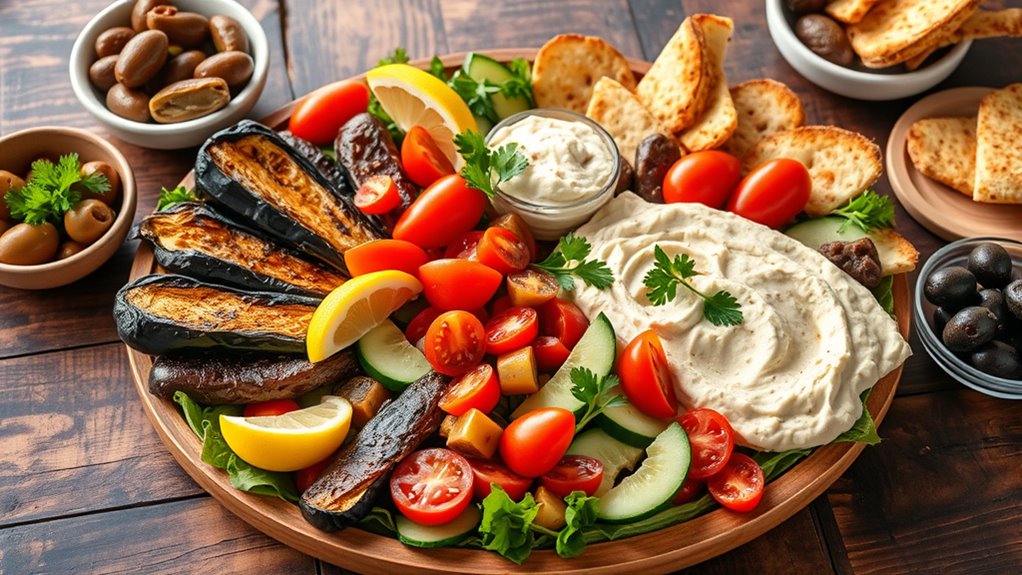
Achieving a satisfying Mediterranean vegetarian meal depends on skillfully balancing flavors and textures. To do this, focus on flavor pairing—combining herbs, spices, and ingredients that complement each other—and ensuring textural balance. Imagine:
Balance flavors and textures with herbs, spices, and ingredients for a delicious Mediterranean vegetarian meal.
- Crispy roasted chickpeas adding crunch to a tender vegetable stew
- Creamy hummus paired with crunchy cucumber slices in a vibrant salad
- Juicy cherry tomatoes mixed with hearty grains for a satisfying bite
Meal Planning and Prep Tips for Success
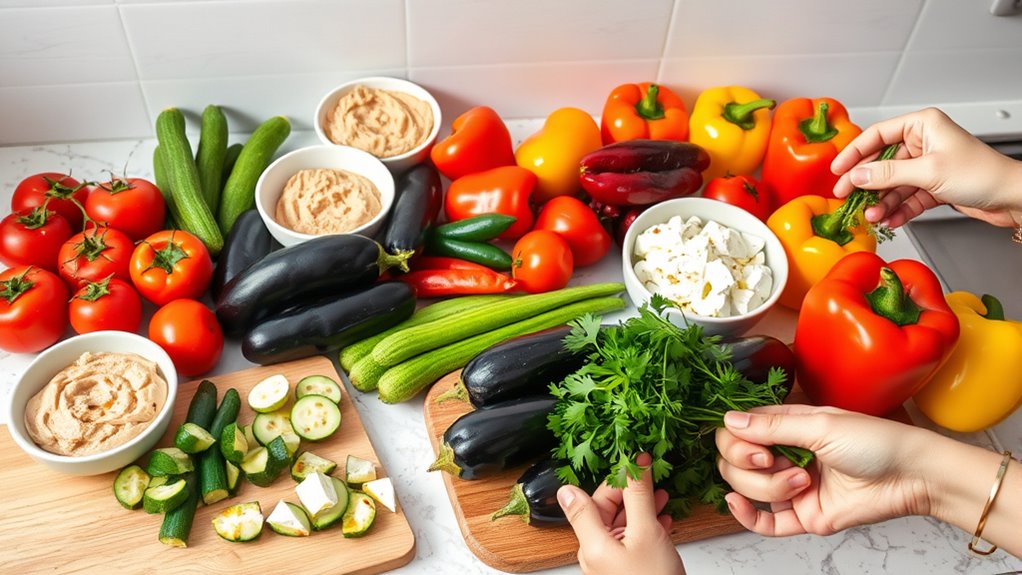
Effective meal planning and prep are key to consistently creating satisfying Mediterranean vegetarian dishes that balance flavors and textures. Start with meal prep strategies, such as batching ingredients like grains, roasted vegetables, and legumes, so you can quickly assemble meals throughout the week. Use portion control techniques, like pre-measuring servings or using smaller containers, to avoid overeating and ensure balanced meals. Planning ahead helps you shop efficiently, reducing waste and unnecessary purchases. Incorporate a variety of colorful produce, whole grains, and healthy fats to keep meals interesting and nutritious. Keep a flexible menu plan to accommodate cravings or seasonal ingredients. With these strategies, you’ll streamline your cooking process and stay on track with your transition to a Mediterranean-style vegetarian diet.
Navigating Dining Out and Social Situations

When dining out or socializing, it’s important to clearly communicate your dietary needs to hosts or restaurant staff. Choosing venues that offer Mediterranean vegetarian options makes it easier to stick to your goals without hassle. Be prepared to handle peer pressure politely but confidently, so you stay true to your new habits.
Communicating Dietary Needs
Managing dining out and social situations can feel challenging when you’re shifting to a Mediterranean vegetarian diet, but clear communication makes all the difference. Be specific about your needs, such as requesting smaller meal portioning or avoiding certain ingredients. When ordering, consider these steps:
- Clearly state your dietary preferences and restrictions upfront.
- Ask to see labels or ingredient lists to ascertain meals align with your vegetarian goals.
- Confirm that portion sizes are appropriate, especially if you’re mindful of intake.
Choosing Venues Wisely
Choosing the right venues can make your shift to a Mediterranean vegetarian diet much smoother. When selecting a restaurant or social setting, consider places known for fresh, plant-based dishes and clear menu options. Good venue selection guarantees you’re more likely to find meals that align with your new diet without frustration. Look for establishments that prioritize meal presentation, as attractive, well-prepared dishes can inspire confidence in your choices and make dining out enjoyable. Research menus ahead of time or call ahead to confirm vegetarian options meet Mediterranean standards. By choosing venues that cater to your dietary needs, you’ll reduce stress, enjoy social gatherings, and stay committed to your transition seamlessly. Remember, thoughtful venue selection is key to maintaining your new eating habits comfortably.
Handling Peer Pressure
Finding your way through social situations can be challenging when you’re shifting to a Mediterranean vegetarian diet, especially if peers pressure you to choose less suitable options. Peer influence and social pressure might tempt you to stray from your new habits. To handle this, consider these strategies:
- Politely decline by saying, “I’m trying to stick to my vegetarian goals,” which sets boundaries without confrontation.
- Suggest alternative dishes that fit your diet, like a vibrant vegetable platter or hummus with pita bread.
- Bring your own snacks or meals to social events to ensure you have satisfying options.
Tracking Your Progress and Staying Motivated
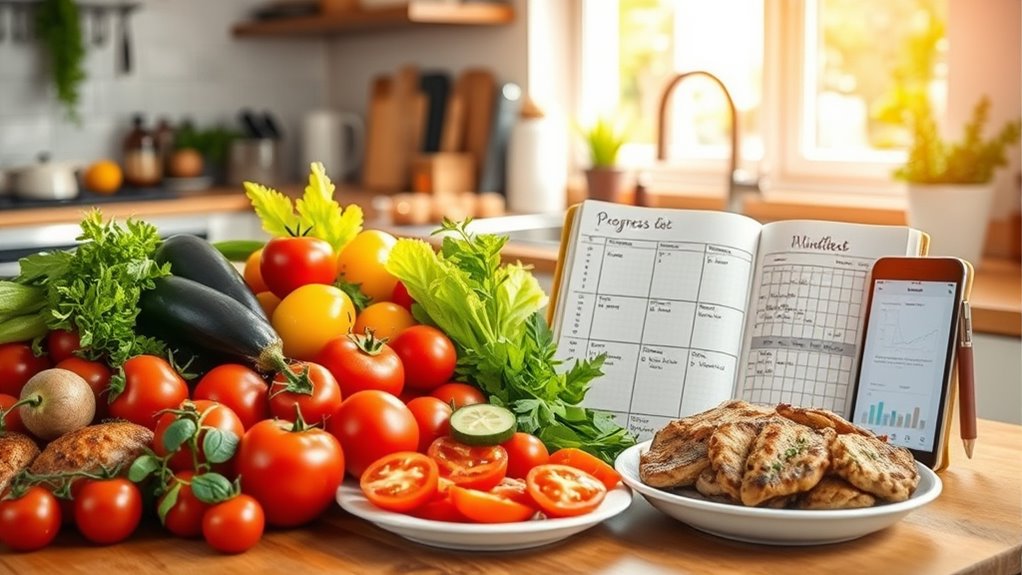
Ever wonder how to stay on track and keep your motivation high when switching to a Mediterranean vegetarian diet? Tracking your progress helps you see how far you’ve come, boosting your motivation. Use a simple journal or app to record meals, energy levels, and cravings. Motivation strategies like setting small goals or rewarding milestones keep you engaged. To help visualize your journey, try this table:
| Week | Achievements | Next Goals |
|---|---|---|
| 1 | Tried new recipes | Add more vegetables |
| 2 | Reduced meat intake | Experiment with legumes |
| 3 | Felt more energetic | Incorporate whole grains |
Regular check-ins with your progress tracking foster accountability and highlight successes, fueling your commitment.
Embracing the Lifestyle Change for Long-Term Health
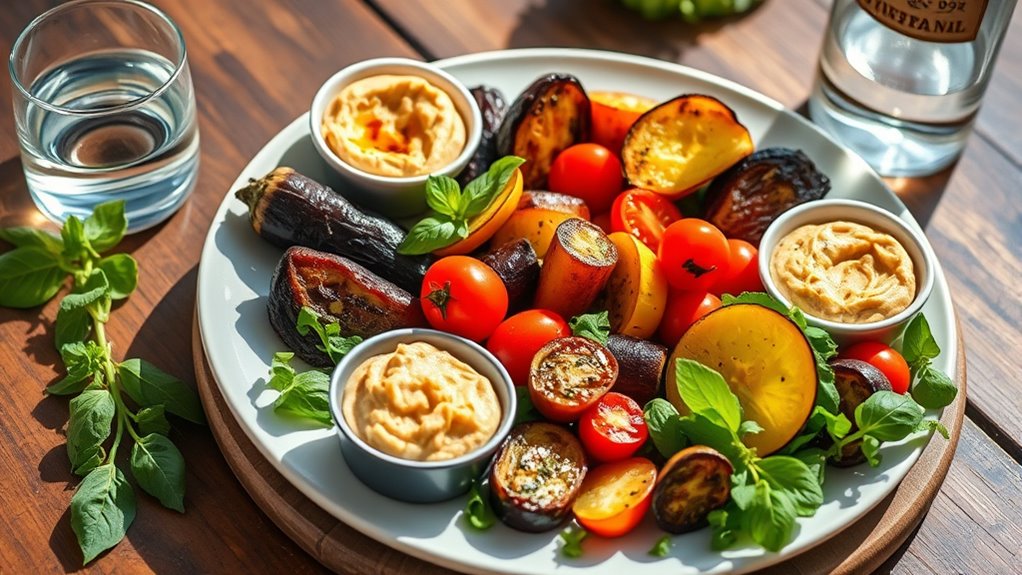
Once you’ve started tracking your progress and celebrating small wins, it’s time to focus on making this dietary shift a lasting part of your lifestyle. Embracing long-term health requires mindful eating, where you pay attention to how foods make you feel and honor your body’s signals. Cultural influences can also enrich this journey—try incorporating traditional Mediterranean dishes or cooking methods that resonate with your background. To solidify these changes, picture yourself:
- Savoring a colorful vegetable salad, appreciating each bite’s freshness.
- Sharing a meal with friends or family, reinforcing social bonds and cultural roots.
- Planning weekly meals that reflect your values and preferences, making healthy choices effortless. By integrating mindful eating and cultural influences, you create sustainable habits that support lifelong wellness.
Frequently Asked Questions
How Can I Ensure Adequate Iron and B12 Intake Without Meat?
To make certain you get enough iron and B12 without meat, focus on plant-based sources like spinach, lentils, and fortified cereals for iron, and nutritional yeast or fortified plant milks for B12. You might also consider supplement options, especially for B12, as it’s primarily found in animal products. Regularly check your levels with your healthcare provider to stay healthy while enjoying a vegetarian diet.
What Are Common Challenges When Transitioning to a Vegetarian Mediterranean Diet?
Exploring new culinary waters can be tricky, especially when facing common challenges. You might find meal planning becomes more detailed, requiring thoughtful choices to guarantee nutrients like iron and B12 are covered. Cultural adaptation also plays a role, as you learn to embrace Mediterranean flavors and traditions. But with patience and curiosity, you can gradually shift your habits, making the transition enjoyable and sustainable while preserving your nutritional balance.
How Do I Handle Family Preferences and Dietary Restrictions?
You should practice open family communication to address everyone’s preferences and dietary restrictions. Share your reasons for switching to a Mediterranean-style vegetarian diet, and listen to their concerns. Be willing to make dietary compromises by preparing versatile meals that include vegetarian options alongside traditional favorites. This approach encourages understanding and cooperation, making mealtime enjoyable for everyone while respecting individual needs and promoting a healthier lifestyle together.
Are There Specific Mediterranean Herbs or Spices That Aid in Flavor?
Imagine transforming bland dishes into vibrant creations—Mediterranean herbs and spices do just that. Herb flavor profiles like basil, oregano, and thyme add freshness, while spice blends such as za’atar and ras el hanout bring warmth and depth. These seasonings don’t just enhance taste; they create a fragrant, lively experience that elevates vegetarian meals, making every bite as exciting as the first.
How Can I Make Vegetarian Meals More Filling and Satisfying?
To make vegetarian meals more filling and satisfying, focus on smart protein pairing and fiber sources. Combine plant-based proteins like beans, lentils, or tofu with whole grains such as quinoa or brown rice to boost satiety. Add fiber-rich veggies, nuts, and seeds for extra fullness. These choices help you feel full longer, provide essential nutrients, and keep your meals flavorful and satisfying, making your progression smoother and enjoyable.
Conclusion
By making this shift, you’re not just changing your diet—you’re transforming your life into a vibrant, health-boosting adventure! Imagine feeling unstoppable energy, radiant skin, and a zest for every day that’s so powerful, it could move mountains. Stick with it, embrace the Mediterranean magic, and watch as your health skyrockets to levels you never thought possible. This isn’t just a diet; it’s your ticket to the most incredible, energized, and delicious life you’ve ever imagined!
Aurelia is the Editor-in-Chief of The Graceful Kitchen, a vegan lifestyle blog that focuses on delicious, nutritious, and ethical eating. A lifelong vegan, Aurelia is passionate about sharing her love of plant-based cuisine with others. She is a regular contributor to several online and print publications, and has been interviewed by major news outlets about the benefits of a vegan diet. In her free time, Aurelia enjoys cooking, hiking, and spending time with her cats.
